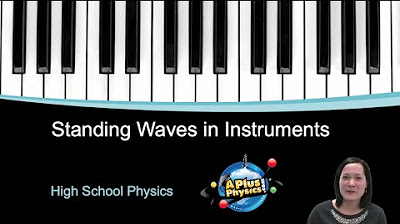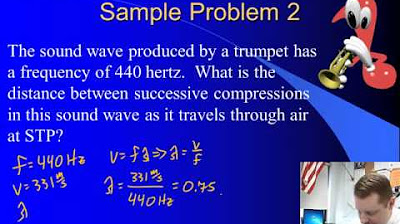AP Physics Workbook 10.J Standing Waves in Tubes
TLDRThis tutorial delves into the concepts of mechanical waves and sound, specifically focusing on standing waves in a tube. It explains the relationship between wavelength and tube length for open and closed tube scenarios, detailing how to calculate the fundamental frequency and higher harmonics. The video uses a step-by-step approach to demonstrate how frequency increases by 60 Hz with each harmonic for an open tube, and 30 Hz for a closed tube, providing clear examples and calculations to enhance understanding.
Takeaways
- 📚 The tutorial covers Unit 10 on mechanical waves and sound, focusing on standing waves in a tube.
- 🌐 The pipe in question is 3 meters long and filled with a gas where the speed of sound is 360 m/s.
- 🎵 Standing waves are formed at different harmonics, with the longest wave corresponding to the lowest frequency.
- 📊 For an open tube at both ends, the length of the tube is equal to one-half the wavelength to form the first harmonic.
- 🔄 The first harmonic, or fundamental frequency, has a wavelength twice the length of the tube (λ = 2L).
- 🚦 The frequency of the first harmonic can be calculated using the formula: frequency = velocity / wavelength (f = v / λ).
- 🔢 For the given values, the first harmonic has a frequency of 60 Hz (f = 360 m/s / 6 m).
- 🌱 As you move to higher harmonics, the wavelength decreases and the frequency increases, following a pattern of adding 60 Hz for each successive harmonic.
- 🌀 When the pipe is closed at one end, the wavelength formulas change, with the first harmonic having a wavelength equal to twice the length of the tube (λ = 4L).
- 📈 The frequency pattern for closed pipes also increases by 30 Hz for each harmonic, but the starting frequency is different due to the change in wavelength.
- 📝 The tutorial emphasizes the importance of understanding and memorizing these wave and frequency relationships for solving problems in physics.
Q & A
What is the length of the pipe considered in the tutorial?
-The length of the pipe considered in the tutorial is 3 meters.
What is the speed of sound in the gas within the pipe?
-The speed of sound in the gas within the pipe is 360 meters per second.
What is the relationship between the length of the pipe and the wavelength for an open tube at both ends?
-For an open tube at both ends, the length of the pipe is equal to one-half the wavelength.
How is the fundamental frequency, or the first harmonic, determined in an open pipe?
-The fundamental frequency in an open pipe is determined by using the formula where the length of the pipe (L) equals half the wavelength (λ), and then using the velocity (v) equation, v = frequency × wavelength, to find the frequency.
What is the frequency of the first harmonic for the given pipe?
-The frequency of the first harmonic for the given pipe is 60 Hertz.
How does the wavelength change from the first to the second harmonic in an open pipe?
-From the first to the second harmonic in an open pipe, the wavelength changes from being one full wavelength to one wavelength plus a half, meaning the length of the pipe is now equal to the full wavelength.
What is the frequency of the second harmonic in the pipe?
-The frequency of the second harmonic in the pipe is 120 Hertz.
How does the pattern of frequencies change for the harmonics in a closed pipe at one end compared to an open pipe?
-In a closed pipe at one end, the frequencies increase in jumps of 30 Hertz for each successive harmonic, whereas in an open pipe, they increase by 60 Hertz for each harmonic.
What is the formula for the wavelength in the third harmonic for a closed pipe?
-The formula for the wavelength in the third harmonic for a closed pipe is λ = (3/2) * L, where L is the length of the pipe.
What is the frequency of the third harmonic in the closed pipe?
-The frequency of the third harmonic in the closed pipe is 100 Hertz.
How can you predict the frequencies for the higher harmonics in a closed pipe?
-You can predict the frequencies for the higher harmonics in a closed pipe by adding 30 Hertz to the frequency of each previous harmonic, starting from the first harmonic.
Outlines
📚 Introduction to Mechanical Waves and Sound
This paragraph introduces the topic of mechanical waves and sound, specifically focusing on unit 10 of the AP Physics workbook. The discussion centers around standing waves in a tube, which is a 3-meter long pipe filled with a gas where the speed of sound is 360 meters per second. The concept of harmonics is introduced, highlighting the longest frequency and the progression through the different harmonics. The notes provided offer insights into the relationship between the wavelength and the length of the tube for an open tube at both ends, explaining how the length is determined by specific fractions of the wavelength. The first harmonic, also known as the fundamental frequency, is explored in detail, with calculations provided to determine the wavelength and frequency.
🌐 Second and Third Harmonics in an Open Tube
This paragraph delves into the second and third harmonics in an open tube. It explains that the second harmonic corresponds to a wavelength equal to the length of the tube, resulting in a frequency of 120 hertz. The third harmonic is described as having a wavelength of three over two times the length of the tube, leading to a frequency calculation with an error that is subsequently corrected. The paragraph emphasizes the pattern of increasing frequency by 60 hertz for each successive harmonic and provides a visual representation of the standing waves at different harmonics.
🚫 Closed Pipe Harmonics and Frequency Adjustments
The discussion shifts to a closed pipe at one end, contrasting it with the open pipe from the previous paragraphs. The first harmonic for a closed pipe is defined by a length equal to half the wavelength, resulting in a frequency of 30 hertz. The paragraph outlines the appearance of the standing wave for the first and third harmonics in a closed pipe, noting the pattern of almost complete wavelengths and the resulting frequencies. It also highlights the difference in frequency increments between open and closed pipes, with closed pipes increasing by 30 hertz for each harmonic.
🎵 Harmonic Frequencies and Patterns in Closed Pipes
This paragraph focuses on the calculation of harmonic frequencies for a closed pipe, illustrating the pattern of adding 30 hertz for each successive harmonic. It explains how to find the frequencies for the fifth, seventh, and eleventh harmonics using the established pattern. The paragraph also describes the visual representation of the standing waves at these harmonics, emphasizing the incremental increase of 60 hertz from one harmonic to the next. The explanation includes a method for determining the frequencies of additional harmonics by continuing the pattern of adding 30 hertz.
Mindmap
Keywords
💡Mechanical Waves
💡Standing Waves
💡Harmonics
💡Wavelength
💡Frequency
💡Speed of Sound
💡Open Tube
💡Closed Tube
💡Fundamental Frequency
💡Harmonic Series
💡Wave Speed Equation
Highlights
The tutorial covers Unit 10 on Mechanical Waves and Sound, focusing on standing waves in a tube.
The pipe under consideration is 3 meters long and the speed of sound in the gas is 360 meters per second.
The longest frequency is associated with the longest wave, and the analysis involves going through all the harmonics.
For an open tube at both ends, the length equals one-half the wavelength, forming the first harmonic or fundamental frequency.
The relationship between wavelength and length of tube or string is derived through mathematical calculations.
The first harmonic is represented by half a wave in the tube, with the wavelength being twice the length of the pipe.
The frequency is calculated using the velocity and wavelength, resulting in 60 hertz for the first harmonic.
The second harmonic occurs when the wavelength is equal to the length of the tube, resulting in a frequency of 120 hertz.
The third harmonic is characterized by a wavelength of one and a half the length of the tube, leading to a frequency of 100 hertz.
The process of calculating the harmonics is repeated for different wavelengths and frequencies, with each harmonic adding 60 hertz to the previous one.
When the pipe is closed at one end, the first harmonic is defined by the length being equal to one-half the wavelength, resulting in a 30 hertz frequency.
The second harmonic for a closed pipe is almost a complete wave, with three-fourths of a wavelength, leading to a frequency of 90 hertz.
The pattern for closed pipes involves adding 30 hertz for each successive harmonic, with the third harmonic at 90 hertz and the fifth at 150 hertz.
The tutorial visually demonstrates the standing waves in the tube, explaining the formation of harmonics and their corresponding frequencies.
The mathematical relationship between the length of the tube, the wavelength, and the frequency is crucial for understanding the behavior of standing waves.
The tutorial provides a comprehensive understanding of the physics behind standing waves in tubes, with practical applications in music and acoustics.
Transcripts
5.0 / 5 (0 votes)
Thanks for rating:





